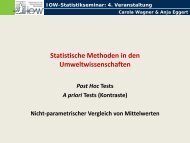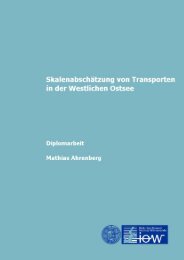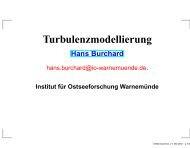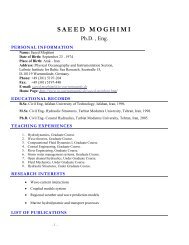The Oder Estuary - IOW
The Oder Estuary - IOW
The Oder Estuary - IOW
Erfolgreiche ePaper selbst erstellen
Machen Sie aus Ihren PDF Publikationen ein blätterbares Flipbook mit unserer einzigartigen Google optimierten e-Paper Software.
Schernewski, G. & T. Dolch (eds.): <strong>The</strong> <strong>Oder</strong> <strong>Estuary</strong> – against the background of the European Water Framework<br />
Directive. Marine Science Reports 57 (2004). ISSN: 0939-396X.<br />
A dynamic box model of the Szczecin Lagoon nutrient cycling<br />
and its first application to the calculation of the nutrient budget<br />
Magdalena Wielgat & Zbigniew Witek<br />
Sea Fisheries Institute, Kollataja 1, 81-332 Gdynia, Poland<br />
Email: wielgat@mir.gdynia.pl, zwitek@mir.gdynia.pl<br />
Summary<br />
In the present paper a dynamic biogeochemical box model of the nutrient cycling within the <strong>Oder</strong><br />
River estuary – the Szczecin Lagoon is presented. <strong>The</strong> model structure is described in detail and<br />
with some general results of the model application to the nutrient budget calculations for the<br />
1980-99 period are given.<br />
1 Introduction<br />
1.1 Introduction<br />
<strong>The</strong> Szczecin Lagoon (in German – <strong>Oder</strong> Haff, Stettiner Haff, in Polish – Zalew Szczeciński) is<br />
one of the key elements of the <strong>Oder</strong>/Odra River estuary (Figure 1.1). Biogeochemical processes<br />
which are part of the functioning of Szczecin Lagoon system influence the quality of the riverine<br />
waters when they finally enter the Baltic Sea. <strong>The</strong> impact of the <strong>Oder</strong> waters on the Baltic Sea is<br />
important, since it is the 5 th largest river in terms of water flow in the whole Baltic Sea drainage<br />
area. <strong>The</strong> <strong>Oder</strong> River drains over 120,000 km² of densely populated and industrialized catchment,<br />
where arable land covers about 50 % of its total area and<br />
the river discharges high loads of nutrients to the sea. In<br />
this paper we present a dynamic biogeochemical box<br />
model describing main processes contributing to the<br />
nutrient cycling within the estuary with the emphasis on<br />
the main part of the estuary – the Szczecin Lagoon. <strong>The</strong><br />
present model represents the approach undertaken by<br />
HUBMORG et al. (2000) to study long-term changes in<br />
biogeochemical processes contributing to the <strong>Oder</strong><br />
River nutrient loads modifications in the river estuary.<br />
However, we think that in this approach the seasonal<br />
pattern of nutrient concentrations and phytoplankton<br />
growth is represented better, as compared to the<br />
approach by HUBMORG et al. (2000). <strong>The</strong> present model<br />
is designed to be used to study nutrient budget of the<br />
<strong>Oder</strong> estuary. In previous works the nutrient transport<br />
and budget within the western part of the <strong>Oder</strong> estuary<br />
was modeled by a hydrodynamic model coupled with<br />
nutrient measurements (MEYER et al. 1998; LAMPE<br />
Fig. 1.1 <strong>The</strong> <strong>Oder</strong> <strong>Estuary</strong>.<br />
1999), this was, however, a short term calculation for<br />
the period 1993-95. In the present paper the model








